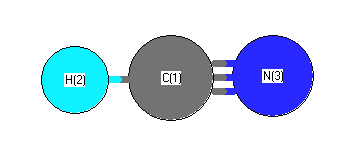Vibrational Frequencies calculated at MP2/6-311+G(3df,2p)
| Mode Number |
Symmetry |
Frequency
(cm-1) |
Scaled Frequency
(cm-1) |
IR Intensities
(km mol-1) |
Raman Act
(Å4/u) |
Dep P |
Dep U |
|---|
| 1 |
Σ |
3465 |
3269 |
78.36 |
33.77 |
0.19 |
0.32 |
| 2 |
Σ |
2030 |
1915 |
0.20 |
42.70 |
0.08 |
0.15 |
| 3 |
Π |
731 |
690 |
36.59 |
0.21 |
0.75 |
0.86 |
| 3 |
Π |
731 |
690 |
36.59 |
0.21 |
0.75 |
0.86 |
Unscaled Zero Point Vibrational Energy (zpe) 3478.7 cm
-1
Scaled (by 0.9434) Zero Point Vibrational Energy (zpe) 3281.8 cm
-1
See section
III.C.1 List or set vibrational scaling factors
to change the scale factors used here.
See section
III.C.2
Calculate a vibrational scaling factor for a given set of molecules
to determine the least squares best scaling factor.
